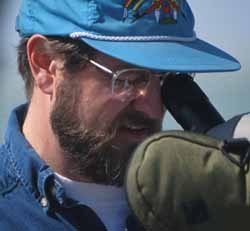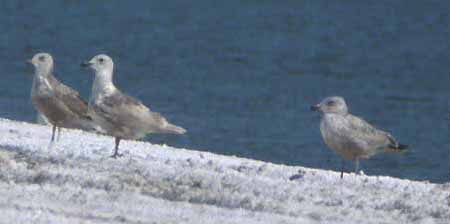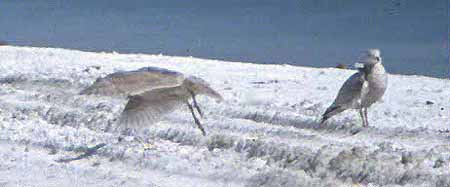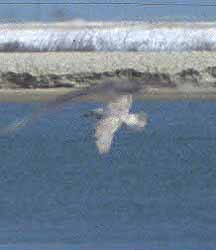FIRST RECORD OF GLAUCOUS-WINGED GULL IN KINGS
CO., CALIFORNIA
photos and discussion by Don Roberson
and the story of a Kings Co. Big Day (story by Luke Cole, below)
 Luke Cole (left) discovered a Glaucous-winged Gull Larus glaucescens
on 22 Mar 1999 in southern Kings County, and I refound it on a 'Big Day'
on 27 March with Luke, Rita Carratello, and Rob Hansen. It appeared to
be in first-summer plumage, having molted in a gray back and replaced most
head/body feathers, but retaining first-winter coverts and juv. wings and
tail. The photos below show it (center or center-left gull in all photos)
with Herring Gulls L. argentatus smithsonianus. It was a tad larger
than Herring, with an essentially all-black bill (all first-year Herrings
had variably pale bases to bill), and classic mocha-colored primaries uniform
in color with the wing-coverts.
Luke Cole (left) discovered a Glaucous-winged Gull Larus glaucescens
on 22 Mar 1999 in southern Kings County, and I refound it on a 'Big Day'
on 27 March with Luke, Rita Carratello, and Rob Hansen. It appeared to
be in first-summer plumage, having molted in a gray back and replaced most
head/body feathers, but retaining first-winter coverts and juv. wings and
tail. The photos below show it (center or center-left gull in all photos)
with Herring Gulls L. argentatus smithsonianus. It was a tad larger
than Herring, with an essentially all-black bill (all first-year Herrings
had variably pale bases to bill), and classic mocha-colored primaries uniform
in color with the wing-coverts.


 There were several points that I found interesting about this gull, beyond
it establishing the first King Co. record of the species. First, to my
eye, the mantle color seemed slightly darker than I would have expected,
but I suspect this is an artifact of comparing fresh back/scapular feathers
against worn coverts. The apparent contrast is less obvious (more "normal-colored")
in the lower flight shot (all photos are rather distant as the gulls on
the dike were quite skittish). Second, the bird had a slight secondary
bar and a slightly darker tail in flight than expected (note paler bleached
color to central rectrices, though), but I find these well within the range
of variation shown by Glaucous-winged Gulls on the Monterey Peninsula (where
I see them daily). To me the bill size, shape, and color were typical Glaucous-wing.
There were several points that I found interesting about this gull, beyond
it establishing the first King Co. record of the species. First, to my
eye, the mantle color seemed slightly darker than I would have expected,
but I suspect this is an artifact of comparing fresh back/scapular feathers
against worn coverts. The apparent contrast is less obvious (more "normal-colored")
in the lower flight shot (all photos are rather distant as the gulls on
the dike were quite skittish). Second, the bird had a slight secondary
bar and a slightly darker tail in flight than expected (note paler bleached
color to central rectrices, though), but I find these well within the range
of variation shown by Glaucous-winged Gulls on the Monterey Peninsula (where
I see them daily). To me the bill size, shape, and color were typical Glaucous-wing.
I found it interesting that the primaries and coverts -- although surely
bleached somewhat -- were not nearly was worn and bleached-out as many
Glaucous-winged Gulls on the coast at this date (not to mention really
ratty California and Western gulls by now). The remiges were remarkably
well preserved for late March. This recalls the same situation with a first-year
Glaucous-winged Gull I discovered in Nebraska on 12 Apr 1995 (a first record
for that state; text of article in Nebraska Bird Review is on line
here).
Could these birds have spent the earlier part of winter farther north (with
less day-length to bleach feathers) than some of the local Glaucous-wings
(and other gulls) that have been in central California since perhaps October?
-- Don Roberson, Pacific Grove CA
The story of the Big Day was posted to the "CALBIRD" & "County Lister"
discussion groups on Sunday, 28 Mar 1999, by Luke Cole [and is reprinted
below with permission]
KINGS COUNTY BIG DAY
Yesterday, Saturday March 27, the intrepid team of Rita Carratello,
Rob Hansen, Don Roberson and I did a Big Day in that great under-birded
county, Kings. Highlights included refinding a first county record of GLAUCOUS-WINGED
GULL, refinding the wintering BROWN PELICAN (2nd county record), a very
early WILSON'S PHALAROPE, 11 species of sparrow, 3 owls, and other fun
birds for the Central Valley like GREATER SCAUP, GREAT-TAILED GRACKLE,
and WRENTIT. A confluence of events (access to private property on
the west, east and south sides of the county) and good birds made for a
great day and a county big day record which will be tough to best.
Don had suggested we do a trip in late March, rather than the more typical
big day times in mid-to-late April, which turned out to be a great idea.
We met in Kettleman City Saturday morning to make an assault on the Kings
County big day record, of 108, set by Rob Hansen in September '97. I had
had 107 in September '98 with Gerry Weinberger, but had never done a spring
effort. I had carefully mapped out a route going roughly clock-wise around
the county starting in the southwest, which I predicted would get us at
least 113 species and could yield 120 if we had luck -- which we did...
PLEASE NOTE THAT ALL OF THE BIRDING LOCATIONS NOTED BELOW THAT ARE NOT
ON PRIVATE PROPERTY ARE DESCRIBED ON "LUKE'S GUIDE TO BIRDING KINGS COUNTY,"
FOUND ON JOE MORLAN'S CALIFORNIA COUNTY BIRDING PAGES AT http://fog.ccsf.cc.ca.us/~jmorlan/kingbirding.htm.
We began at 5:30 at Kettleman City, knocking off House Sparrow, House
Finch, E. Starling and WC Sparrow from the hotel parking lot. En route
to Tar Canyon we picked up a Raven and Mourning Dove. Our first stop of
the morning was TAR CANYON ROAD, a private road up into the foothills for
which I had arranged access (the two metal gates across the road make it
a rough 6-mile foot trip otherwise). Although it was lighter than we expected
(we had hoped to reach the top in the dark, but it was becoming light even
as we got to the gate!), we quickly picked up a Meadowlark, Red-tailed
Hawk, Harrier, and singing Grasshopper Sparrow (by the second locked gate).
A distant calling Great Horned Owl was heard by two. RW Blackbird, Cal
Quail, Cal Towhee, Western Kingbird, Kestrel, Brewers BB, Scrub Jay, Shrike,
Say's Phoebe (nesting at the rocky outcrop about 5 miles in), Spotted Towhee,
Junco, Yellow-rumped Warbler, Rock Wren, Savannah and Lark Sparrows were
all there as expected. At the top of the road, Don urged us up a
previously unexplored canyon, where we picked up singing California Thrasher
and Wrentit, both unusual birds for the county, and Rufous-crowned Sparrow
and a singing Roadrunner. Bewick's and House wrens vocalized, and a pair
of Mallard overhead gave us our first waterfowl. Rob flushed a Barn Owl
from its roost for an excellent morning score. On our way down the hill
we lucked into a Ferruginous Hawk sitting in a field, and my staked out
Tricolored Blackbirds were only a half-mile from where they had been on
Monday. I had given us until 8 am to "do" the Canyon, and estimated we
had to pick up at least 22 species there. I locked the gate at 7:59,
and we already had 36 for the day.
Our next stop was all the way across the county, almost an hour away,
at Burris Park. En route Rob's eagle eye netted us Cedar Waxwings in Avenal,
and we picked up Robin, Crow, Tree Swallow, WF Ibis, Black Phoebe and Whimbrel.
As we passed a flooded field at 65 mph on the highway, Rita called out
"Marbled Godwit" but we were already beyond it. I said, "we'll pick
that up at a couple of spots later..."
We got to Burris Park at 8:54, and quickly added its common attractions:
Flicker, Coot, Killdeer, RC Kinglet, Acorn and Nuttall's woodpeckers, Bushtit,
Mocker, GC, Fox and Lincoln's Sparrow, Orange Crowned Warb, American and
Lesser Goldfinch, Greater Yellowlegs, PB Grebe and Red-shouldered Hawk.
Calling White-breasted Nuthatch and Wood Duck were nice additions, as was
Snipe and Green Heron (I had several of these birds staked out later on
in the day, and we saved time picking them up early). A Hermit Thrush
was a bonus. Rob heard a Downy Woodpecker call, but none of the rest of
us could get on it and we could not refind it -- another bird that haunted
us, as we never saw or heard one again.
My "sure thing" spot for Titmouse -- Kings Row, 1/2 mile south of Clinton
on 6th -- was a bust, and we never saw one all day. We were feeling
good, though, as we were 4 (four) minutes ahead of schedule and while I
had predicted 54 birds, we were already at 68 and counting by 10 am.
En route south we picked up Horned Lark. We stopped briefly by the ponds
at 7th and Iona, which were very small (1/10 their normal size) but gave
us GB Heron, Yellow-headed Blackbird, Cinnamon Teal, Great Egret, BB Plover,
RB Gull, Least and Western sandpipers, Dunlin, Pipit, Avocet and Stilt,
Ruddy Duck and Green-winged Teal. We were ahead of schedule, so a quick
detour to the Hanford Sewer Ponds was decided on, which yielded us only
Eared Grebe
(which we would have repeatedly throughout the day). En route we picked
up Cliff and Barn Swallows.
By 11 am we were on private property off Nevada Avenue, scopes out in
10-15 knot breeze. Snowy Egret, Rough-winged Swallow, Lesser Scaup, Gadwall,
Pintail, Shoveler, Clark's Grebe and Song Sparrow lifted our spirits as
the wind picked up. Careful scoping (and a nice flight view) gave us Greater
Scaup, a rare bird for the valley, and Rob had a Bufflehead.
We motored east on Nevada Avenue to the massive Corcoran Reservoir at
6th and Nevada, where my target birds of Double-crested Cormorant, White
Pelican, Wigeon, and Canvasback were present, as were dowitchers. Rob's
careful scoping picked us up a LB Curlew and a lone Canada Goose, the only
goose we saw all day. We also had another pair of Bufflehead well seen
by all. We were doing quite well -- according to my schedule, we needed
to leave these ponds by 12:45, and have 90 species under our belt. Leaving
these ponds at 11:58, we had 107 species -- just one short of tying the
record, and before noon! We stopped for gas, and a vain attempt to
find hummingbirds, in Corcoran.
Speeding down 6th avenue south, we picked up Swainson's Hawk to tie
the record, and our cooperative, staked out Brown Pelican was waiting for
us at the corner of 6th and the Homeland Canal to take us to 109 and a
new county big day record (at 12:38 pm!). The pelican, first found in September,
has remarkably survived the winter in Kings County. It is only the
2nd record for the county, with 3 birds present way back in 1983. (Those
wishing to look for it should drive 6th Avenue south of Utica and look
along the canal to the west, and, if it isn't there, drive the Homeland
Canal levee west of 6th).
Heading up the Homeland Canal levee toward the South Wilbur Flood Area,
we had Caspian Tern and Western Grebe, and at the tiny wetland at the corner
of 10th and the Homeland Canal, Marsh Wren, Sora and Virginia rail. We
headed south around the Wilbur, picking up BC Night-heron and Forster's
Tern. At this point we again headed into private property for which
Rob had arranged access, which yielded us Willet, Snowy Plover and Herring
Gull. We also (luckily!) refound a gull which I had seen on Monday
and tentatively identified as a GLAUCOUS-WINGED GULL -- we got good looks
at the bird, photographed it, and confirmed it for a first county record
of that coastal species. Farther south we saw Redhead and Common Moorhen,
and Rita's eagle eyes picked out a soaring Golden Eagle -- an excellent
bird for our day. Rob then found us a Sage Sparrow (of the race cannescens),
and we had a Burrowing Owl flying from Kings into Kern County (for a twofer).
Our prodigious efforts had already brought us to 124 species by this
time, and we were able to scrap several planned stops which I had scouted
but which would yield us no new species, so we headed back north along
6th. It was now 3:15. Rita pulled a Ring-necked Pheasant (#125) out of
a field of alfalfa for us.
We headed back to the spot where earlier Rita had seen the Marbled Godwit,
as we hadn't found another one all day. Unfortunately, the godwit was gone,
but we carefully identified a migrant of flock of a half-dozen Short-billed
Dowitchers (we had seen LB earlier)(#126). We then headed through Lemoore
where Don had staked out (in Nov!) a Great Horned Owl, and we had a family
of 4 (3 hatching year birds -- early nesters!) there, so everyone on the
team now had GHOW.
Heading out Grangeville Boulevard, we checked out Summit Lake, where
Don's expert scoping found a very early Wilson's Phalarope (#127). We then
went to a spot along 26 1/4, north of Elgin, where I had staked out a Great-tailed
Grackle. This bird is rapidly establishing itself in the southern Central
Valley, but there is not yet a reliable spot in Kings County for it, so
I was stoked to find one male the previous afternoon in my scouting.
As we pulled up to my stakeout, I saw a male GT Grackle flying over the
pond and away from us, and quickly got the other three on it as it flew
beyond the pond and out of sight -- a minute later and we would have missed
it. #128.
We then took the road along the Elgin ditch (the north dike along the
canal off of 26 1/4), and had a Sharpie fly across the levee in front of
us, #129. A Kingfisher a few minutes later made it 130, at 5:50 pm.
That would be the last new bird we would see.
As sun set, we headed back toward Kettleman City (and Rob's and my cars),
still trying to eke out that last bird, resorting to driving through trailer
parks looking for ornamental plantings that might have a hummingbird.
These efforts were in vain.
We spent 13 hours at our task (5:30-6:30), and covered 278 miles. All
in all, a great day in the field, exploring some of the nether reaches
of this underbirded county. I had predicted 120 species, but we hit 130
-- smashing the record of 108 by a 22 species. 128 species were seen or
heard by all. We had several big misses: Turkey Vulture, White-tailed Kite,
Anna's Hummer, and Titmouse. However, the combination of the great team
of Don, Rita, and Rob, and Rob's and my knowledge of the county and the
access we had to private property make this big day the standard to beat
in Kings County!
-- Luke Cole, San Francisco, CA <luke@crpesf.org>
 Luke Cole (left) discovered a Glaucous-winged Gull Larus glaucescens
on 22 Mar 1999 in southern Kings County, and I refound it on a 'Big Day'
on 27 March with Luke, Rita Carratello, and Rob Hansen. It appeared to
be in first-summer plumage, having molted in a gray back and replaced most
head/body feathers, but retaining first-winter coverts and juv. wings and
tail. The photos below show it (center or center-left gull in all photos)
with Herring Gulls L. argentatus smithsonianus. It was a tad larger
than Herring, with an essentially all-black bill (all first-year Herrings
had variably pale bases to bill), and classic mocha-colored primaries uniform
in color with the wing-coverts.
Luke Cole (left) discovered a Glaucous-winged Gull Larus glaucescens
on 22 Mar 1999 in southern Kings County, and I refound it on a 'Big Day'
on 27 March with Luke, Rita Carratello, and Rob Hansen. It appeared to
be in first-summer plumage, having molted in a gray back and replaced most
head/body feathers, but retaining first-winter coverts and juv. wings and
tail. The photos below show it (center or center-left gull in all photos)
with Herring Gulls L. argentatus smithsonianus. It was a tad larger
than Herring, with an essentially all-black bill (all first-year Herrings
had variably pale bases to bill), and classic mocha-colored primaries uniform
in color with the wing-coverts.


 There were several points that I found interesting about this gull, beyond
it establishing the first King Co. record of the species. First, to my
eye, the mantle color seemed slightly darker than I would have expected,
but I suspect this is an artifact of comparing fresh back/scapular feathers
against worn coverts. The apparent contrast is less obvious (more "normal-colored")
in the lower flight shot (all photos are rather distant as the gulls on
the dike were quite skittish). Second, the bird had a slight secondary
bar and a slightly darker tail in flight than expected (note paler bleached
color to central rectrices, though), but I find these well within the range
of variation shown by Glaucous-winged Gulls on the Monterey Peninsula (where
I see them daily). To me the bill size, shape, and color were typical Glaucous-wing.
There were several points that I found interesting about this gull, beyond
it establishing the first King Co. record of the species. First, to my
eye, the mantle color seemed slightly darker than I would have expected,
but I suspect this is an artifact of comparing fresh back/scapular feathers
against worn coverts. The apparent contrast is less obvious (more "normal-colored")
in the lower flight shot (all photos are rather distant as the gulls on
the dike were quite skittish). Second, the bird had a slight secondary
bar and a slightly darker tail in flight than expected (note paler bleached
color to central rectrices, though), but I find these well within the range
of variation shown by Glaucous-winged Gulls on the Monterey Peninsula (where
I see them daily). To me the bill size, shape, and color were typical Glaucous-wing.